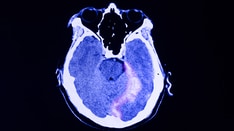
A new falls decision rule could help emergency department (ED) physicians understand which older adults need CT imaging to identify intracranial bleeding after a fall, a study suggests.
The rule, based on a prospective cohort study of more than 4300 adults age 65 years and older who presented to 11 Canadian EDs after a fall, has a sensitivity of 98.6%, a specificity of 20.3%, and a negative predictive value of 99.8%.
Kerstin de Wit, MD, associate professor of emergency medicine at Queen's University in Kingston, Ontario, told Medscape Medical News she was surprised when developing the rule to find that anticoagulant or antiplatelet use did not predict intracranial bleeding in this population. She also found that prior stroke, renal impairment, and a prior history of major bleeding were not associated with intracranial bleeding. Therefore, clinicians do not need to consider these factors when determining whether to perform a CT scan in this population.
Instead, de Wit said, the falls decision rule states that there is no need for a head CT scan if the patient did not hit his or her head, the patient can recall the events of the fall, there is no new neurological deficit on examination, and the patient requires no additional help for any activities of daily living, including housework, driving, and finances.
In a post-hoc analysis, an even simpler-focused falls decision rule was created, she added. That rule states there is no need for a head CT if the patient did not hit his or her head and there is no new neurological deficit on examination. Both rules must be validated in other cohorts before adoption into clinical practice, said de Wit.
The findings were published online December 4 in the Canadian Medical Association Journal.
Mostly Unnecessary
Ordering a head CT scan on every older adult who has fallen is "inefficient and costly" because most do not have intracranial bleeding, write the study authors. Therefore, they aimed to derive a clinical decision rule that could safely exclude clinically important intracranial bleeding in this population without a head CT.
To develop the rule, researchers assessed potential predictor variables in a precursor study of 1753 older patients who had fallen and presented to the ED. They selected 17 candidate variables, including age, sex, head impact on falling, loss of consciousness, amnesia, history of previous major bleed, cirrhosis, previous ischemic stroke, chronic renal impairment, reduced Glasgow Coma Scale score from baseline, bruise or laceration on the head, new abnormality on neurologic examination, hemoglobin < 10 g/L, platelet count < 80 × 109/L, anticoagulant therapy, antiplatelet therapy, and Clinical Frailty Scale score ≥ 5 (which indicates dependence on others for high-order instrumental activities of daily living).
To test the predictors in the current study, researchers enrolled 4308 older adults who presented to 11 Canadian and US EDs after having fallen from standing on level ground, off a chair or toilet seat, or out of bed. Study participants were a median age of 83 years, and 64% were women. About 26% took anticoagulant drugs, and 36% took antiplatelet drugs. A total of 139 (3.2%) participants experienced the primary outcome of clinically important intracranial bleeding within 42 days of the index ED visit.
"As we created the falls decision rule, we noted that two of the four variables identify 95% of all intracranial bleeds," said de Wit. Therefore, in a post-hoc analysis, the team developed the focused falls rule, which has a lower sensitivity (95%) but a higher specificity (38%) than the full rule. The focused rule "also has the advantage of being simpler to apply and easier to remember, although it will require considerable validation," de Wit added.
A study limitation is that ED physicians chose whether to perform a head CT, which "could have inflated the strength of association between predictor variables that are commonly used to make this decision and the diagnosis of intracranial bleeding," the authors write.
In addition, "although patients were advised to return if they developed neurologic symptoms, it is possible intracranial bleeding could have led to recovery or death without being diagnosed." Furthermore, the impact of COVID-19 on the study is unknown.
All Elderly Patients Included

Commenting on the study for Medscape Medical News, Lauren T. Southerland, MD, MPH, an emergency medicine physician at the Ohio State University Wexner Medical Center in Columbus and a clinical associate professor at the Ohio State University College of Medicine said: "As with any clinical decision tool, this will have to be validated prospectively before we can adopt it fully. But if validated, this will help ED physicians weekly, if not daily." Southerland did not participate in the research.
"We frequently struggle with whether or not to perform CT scans on older adults who fall," she said. "Sometimes it is unclear if they even have the short-term recall to remember truly if they hit their head or not.
"This is the first rule I have seen that includes all older adults, including those with dementia and cancer, who are often excluded from studies," she continued. "I also like the incorporation of the Clinical Frailty Scale, as this accounts for the fact that minor trauma has bigger effects on older adults at high levels of frailty. To my knowledge, frailty and cognitive impairment have not been included in any prior clinical decision tools for head trauma."
That said, Southerland would like to see a delirium screening tool added to the assessment. "A brief delirium screen or 3-minute recall test could be done by the ED physician team to assess memory prior to using the falls decision rule," she suggested.
The study was funded by the Canadian Institutes of Health Research. de Wit has reported no relevant financial relationships. Southerland has reported membership in the Geriatric Emergency Department Collaborative.



Comments